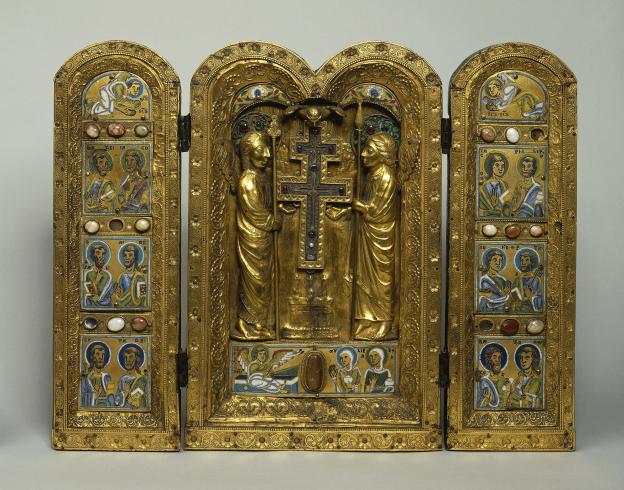The acquisition or transfer of relics in the Middle Ages required the creation of precious reliquaries to exhibit them for veneration by the faithful. Those relating to Christ himself, notably fragments of the wood of the cross, were naturally considered to be the most sacred.
They were placed in staurotheques crafted by various specialists working with precious materials: goldsmiths, ivory carvers, enamellers. Enamel is an artificial vitreous material whose colours are reminiscent of gemstones. The metal, which was either precious or made precious by gilding with gold or silver, could be prepared to contain the enamel in two ways: cloisonné work, which creates little enclosed cells to hold the powder which is then melted, or champlevé work, which largely superseded it from the 12th century, and involves chasing directly into the metal plaque. The metal itself, usually gilded copper, was pushed out by applying pressure to the reverse of the sheet, then chased.
The Petit Palais staurotheque was based on a piece probably created by the Mosan goldsmith Godefroy de Huy († 1175) for the Sainte-Croix church in Liège. The triptych composition and the iconography of angels bearing the instruments of the Passion adoring the cross are Byzantine in origin. The apostles occupy the two side panels. The enamels are applied in solid blocks of colour or are more subtly modulated: blues or greens flecked with yellow or white, shaded with cobalt, etc.
In spite of the generally very reliable tastes of the successive owners of the work – Prince Soltykoff in the first half of the 19th century and the Dutuit family until 1902 – doubts have recently been cast on the absolute authenticity of the work. Laboratory analysis using the most modern techniques available have proven it to be absolutely contemporaneous with known Limousin and Mosan enamels from the 12th and 13th centuries.
P. L.

City of Paris municipal collection's website
The collections portal can be used to search the collections of Paris’s 14 municipal museums (approximately 336,000 works, including 43,000 belonging to the Petit Palais).
It is also possible to download around 12,000 images of the museum’s works free of charge.
Access the Museums of the City of Paris collections portal
Extern databases
Discover a selection of databases online presenting works from the Petit Palais or documents concerning the history of the museum.

